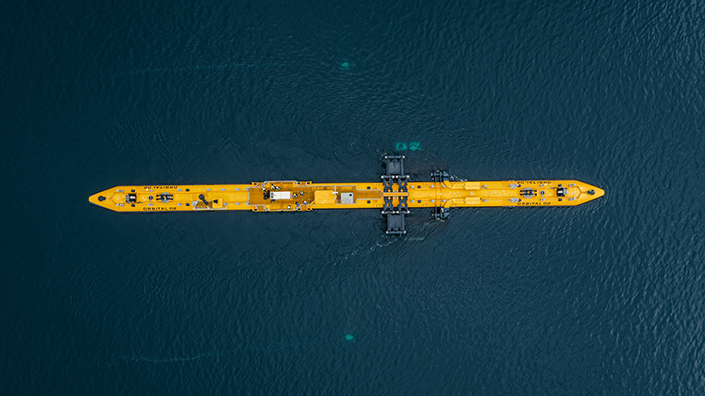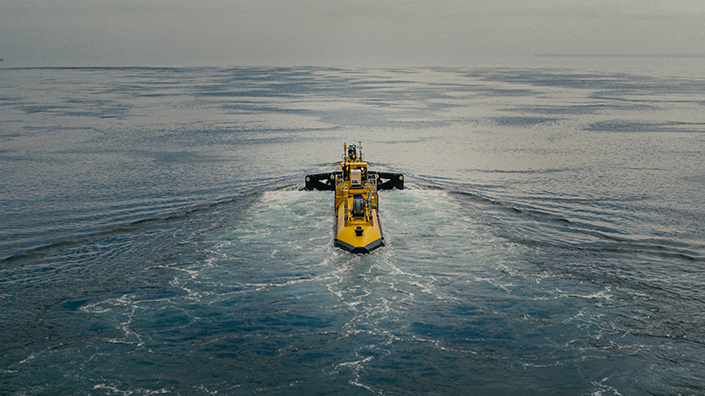Under the surface, large turbine blades are spinning, attached to boat-like platforms sitting motionless on the water. One of these machines is the O2 turbine from Orbital Marine Power, a pioneer in the field of tidal energy – something which could, helped by last week’s government announcement of ‘ring-fenced’ annual funding, offer a valuable new source of zero-carbon electricity.
The O2 is one of a number of marine energy projects being tested in sites run by the European Marine Energy Centre (Emec). In September, we caught up with Orbital CEO Andrew Scott to hear about the company’s progress since an earlier conversation in 2019, testing at Emec, and the future of tidal energy.
We previously spoke in 2019, how have things been since then?
Manic, it’s been a busy period.
O2 was a purely engineering design project for a number of years. Then, as a company, we had to gather together the finance to actually build it in real life. And that was a bit of a challenge in itself. And we're fairly innovative on that front as well, so we actually raised the £7m of commercial debenture... from a slightly unconventional source, which is crowdfunding.
I think I'm still correct in saying that was possibly the largest crowdfunded debenture the UK has seen today... We were also successful in securing some grant support funding from the Scottish Government.
How did manufacturing go?
Following a fairly rigorous tendering process, we went into construction finally with the O2 by the middle of 2019. There were some key contracts, the biggest of which was with a fabrication assembly manufacturer in Dundee, so they were tasked with the job of doing the main fabrication and main assembly of the turbine, and to host that on their facility at Dundee. They actually outsourced a lot of their heavy steel work to another Scottish outfit, which was just across the Tay in Fife.
But we also had composite blades being manufactured down on the south coast of England. There were anchors that came from North Wales. We had hydraulics and hydraulic power units and things like that coming from the Midlands or Sheffield, so it was very much a pan-UK response.

We did issue a commercial contract to assemble the drivetrains to a large Swedish OEM called SKF. They're specialists in bearing and sealing solutions. So that was a partnership that we struck up for the delivery of the nacelles and pitching helps. But other than that, pretty much the whole thing – in fact, over 80% – was delivered through the UK supply chain, stretching from Orkney down to the south coast of England...
So ultimately, at the start of this year, we had a completed O2 turbine. It was launched from Dundee at the end of April, we finally put it in the water. That marked the first vessel to be launched from a Dundee shipyard in 40 years, which was a nice memento for us to take.
What will future iterations of the O2 look like?
We see an ability to make the turbine potentially bigger in the future, where sites may allow for that, but we equally see an ability to make it smaller as well, for slower water or smaller applications. But the immediate requirement is being able to deliver something that is competitive enough from a price perspective that policy setters are prepared to start to endorse and support. We recognise we needed to do it at scale, so the scale that we built to, 2MW, is pretty epic from an engineering perspective. It's about the size of a jumbo jet and it kind of looks like a spaceship...
We've demonstrated that floating technologies have conceptual benefits and unique selling points that clearly can differentiate them from technologies that are bottom-mounted, and that the engineering is robust... Orbital has to take credit with effectively pioneering that, and it's not been a quick story – arguably, we've actually been developing this technology longer than anybody has been developing any tidal technology.

How is testing going?
It's going exactly as we would have expected. So whether we should be pleased with that, I mean, we shouldn't in a way, we spent 15-20 years characterising and detailing the engineering, understanding the working environment and the technology and everything like that. So it's reassuring that the O2 is performing exactly in line with expectations...
There were things that we changed between it and the SR2000... The SR2000 was stall-regulated, so that means that we didn’t have the ability to pitch the blades. That was fairly common in early-stage small wind, but in order to be able to accommodate larger rotor diameters on a like-for-like basis, and the ability to manage structural loads more effectively, pitch control systems are pretty much commonplace in all wind turbines now. So for exactly the same principles, we adopted pitch into the O2. It gives us an ability to manage loads in a more sophisticated way, and that allows us to get more bang for our buck, in a way, out of equipment and swept area.
Hydrogen generation is part of the O2 testing, will that be a significant part of future operations?
That functionality of the project is being managed and administered by Emec, but it's great to be part of it. I think we recognise that everybody's waking up to the realities that we no longer live in an electricity market and a gas market, that there's going to be a convergence – through decarbonisation – of a fairly dynamic energy landscape. And that's going to involve lots of things, which is great for innovators and companies that come up with solutions. It's going to involve both different forms and different locations of low-carbon green electricity production, but equally, on the other side, energy storage both via batteries and through things like hydrogen. None of them are silver bullets, but they've all got some role to play.
Are you seeing more government support now than in 2019?
The investment requirement and investment desire to invest in low-carbon solutions has never been stronger, and I think it's only going to grow... I think there are still challenges to introduce new technologies, and therein lies something that we need to get better at, which is understanding how we bring new technologies into the commercial space more efficiently and quicker, because time is of the essence...
Whether I would go so far as to say that it is full-blown support for the sector, I might not. I think there's still a gap there, both in terms of ring-fencing and actual requirement for tidal, or an ambition for tidal, and getting the pricing correct. I think that's continuously the thorny issue in the side...
80% of the project was delivered within the UK supply chain, we think there's easily an ability to increase that. These are green energy jobs, sustainable ones, and ones that can ultimately lead to an export market that could feed a global market for low-carbon. There has to be, from my perspective – and it would be a logical thing for me to say – I think there needs to be more bold policy initiatives and an acceptance around innovative technologies, and commercialising them and accepting that with that comes the challenge of educating the public.
This interview has been abridged for publication.
Make sure to visit the Professional Engineering website throughout the week (29 November – 3 December) for more Energy Islands stories and interviews.
Want the best engineering stories delivered straight to your inbox? The Professional Engineering newsletter gives you vital updates on the most cutting-edge engineering and exciting new job opportunities. To sign up, click here.
Content published by Professional Engineering does not necessarily represent the views of the Institution of Mechanical Engineers.